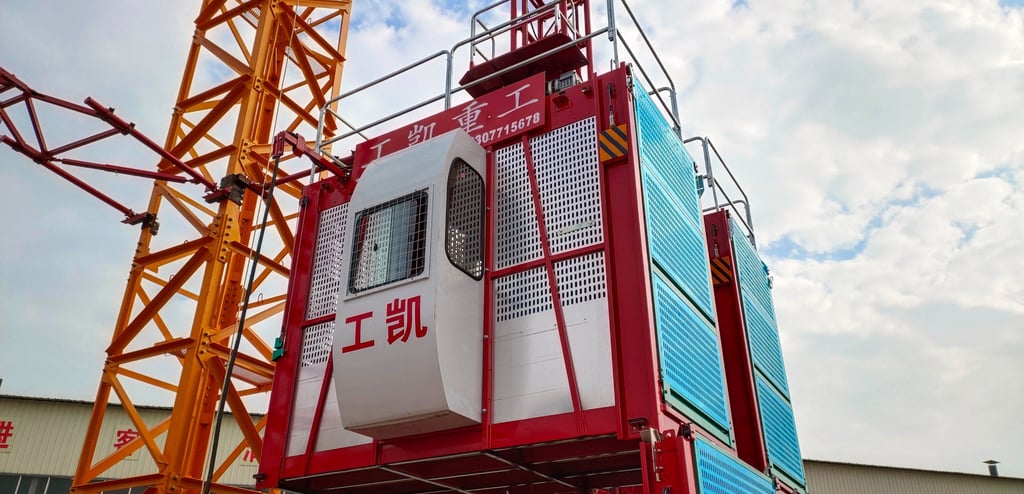What is a Construction Hoist?
10/23/20254 min read


Introduction to Construction Hoists
Construction hoists are critical components in the construction industry, designed to transport materials, tools, and personnel safely and efficiently between different heights on construction sites. These machines not only facilitate the movement of heavy loads but also play a pivotal role in enhancing overall productivity and ensuring safety during building projects. As construction projects often involve multiple stories, the use of hoists significantly reduces the time and labor associated with material handling, allowing workers to focus on their core tasks.
There are several types of construction hoists available on the market, each tailored to meet specific operational needs. The two primary categories include passenger hoists and material hoists. Passenger hoists are primarily used to carry personnel to elevated work areas, while material hoists are designed to transport heavy equipment and building materials. Each type can be selected based on the project requirements, size, and complexity of the construction site.
In addition to improving efficiency, construction hoists also enhance site safety by minimizing manual handling of materials, which can lead to injuries. These machines are equipped with safety features such as overload protection, safety brakes, and emergency stop buttons, ensuring that they operate within safe limits and offering peace of mind to workers and site managers alike.
Moreover, the applications of construction hoists extend beyond traditional building projects. They are increasingly utilized in various sectors, including renovation, scaffolding erection, and infrastructure development. As the construction industry continues to evolve, the demand for sophisticated hoisting solutions grows, highlighting the importance of these machines in streamlining construction processes while prioritizing safety and efficiency.
Types of Construction Hoists
Construction hoists play a critical role in moving materials and personnel across different levels of a building site. Understanding the various types of construction hoists and their specific applications can enable project managers to select the most suitable hoist for their needs. The primary categories include passenger hoists, material hoists, and rack and pinion hoists.
Passenger hoists are designed to transport personnel safely from one floor to another. These hoists are equipped with safety features such as emergency brakes and secure access systems to ensure worker safety during vertical transit. Typically found on high-rise construction sites, passenger hoists can accommodate multiple workers at once, thereby enhancing productivity by reducing downtime associated with climbing stairs or using temporary scaffolding.
Material hoists, on the other hand, are tailored for moving construction materials such as bricks, steel beams, and concrete from ground level to various heights. They often have a higher load capacity than passenger hoists, making them an indispensable tool in large-scale construction projects. With various configurations, material hoists can facilitate quick and efficient loading and unloading, thereby streamlining the workflow on-site.
Rack and pinion hoists serve another unique function. These hoists are primarily used for both passengers and materials but feature a different operational mechanism. They consist of gears and racks that provide stability and precision during movements, making them ideal for projects requiring meticulous lifting operations. The advantages of rack and pinion hoists include smooth operation, high lifting speeds, and rugged designs capable of withstanding harsh site conditions.
The selection of an appropriate type of construction hoist will largely depend on specific project requirements, including the load capacity needed, the height of the building, and prevailing job site conditions. By assessing these factors, construction managers can make informed decisions that enhance efficiency and safety throughout the project lifecycle.
Safety Considerations and Regulations
The use of construction hoists is essential for transporting materials and personnel on job sites, but with this utility comes significant safety responsibilities. Adhering to safety regulations and guidelines is crucial to prevent accidents and ensure a secure working environment. Various regulatory standards, such as those set forth by the Occupational Safety and Health Administration (OSHA), outline the necessary safety measures required for hoist operations. These guidelines dictate everything from design specifications to operational protocols, ensuring construction hoists are safe and reliable.
Regular inspections and maintenance play a vital role in the safety of construction hoists. It is imperative to establish a routine maintenance schedule to identify any potential issues before they become dangerous. According to industry regulations, hoists should be inspected by a qualified individual at specified intervals, ensuring all components, including cables, brakes, and safety devices, are in optimal condition. Failure to maintain equipment can lead to catastrophic failures, endangering both operators and workers on site.
Operator training is another critical safety consideration in hoist operations. Workers must receive comprehensive training on how to operate the equipment safely, including understanding load limits and the function of safety features. Inadequate training can result in improper use, increasing the likelihood of accidents. Furthermore, operators should be familiar with common hazards associated with hoist operations, such as load dropping, mechanical failure, and site-specific dangers like overhead power lines.
To mitigate these risks, implementing safety protocols and using personal protective equipment (PPE) is essential. Establishing clear communication procedures among crew members ensures that everyone is aware of movements and operations related to the hoist. By prioritizing safety measures, adhering to regulations, and fostering a culture of vigilance among operators and workers, the risks associated with construction hoists can be significantly reduced, creating a safer construction site for all involved.
Innovations and Future Trends in Construction Hoisting
The construction industry is undergoing significant transformation, particularly in the realm of hoisting technologies. Recent innovations are redefining how construction hoists operate, focusing on automation and smart technology to enhance efficiency and safety on job sites. These advancements are essential as the demand for faster construction timelines continues to grow. The integration of automated systems in construction hoists allows for precise lifts and improved load management, ensuring that materials are transported swiftly and securely.
Moreover, smart technologies are being incorporated into construction hoisting equipment, enabling real-time monitoring and data collection. This functionality allows operators to closely track hoist performance, identify potential issues before they escalate, and optimize operational schedules. For instance, predictive maintenance powered by data analytics can lead to reduced downtime, enhancing productivity on construction sites. Enhanced safety features, such as automatic load weight sensors and emergency stop systems, further solidify the role of modern construction hoists in maintaining worker safety.
In addition to technological advancements, there is a growing emphasis on sustainability within the construction sector. Innovations in construction hoisting are increasingly focusing on eco-friendly practices, such as using energy-efficient motors and recyclable materials in hoist construction. These efforts align with the industry's commitment to reducing its carbon footprint and adopting greener practices. GKZG are exploring options for electric and hybrid hoisting equipment that significantly lessens emissions and promotes overall environmental stewardship. The future of construction hoists will likely involve more initiatives that prioritize sustainability while maintaining high efficiency and safety standards.
As the construction industry adapts to these innovations, stakeholders can expect construction hoists to play a pivotal role in shaping efficient and sustainable building practices moving forward.
Connect
Get in touch for your project needs today.
Contact us
Email:ann@gkzgtowercrane.com
Tel/Whatsapp/Wechat:+86 13437895301
Copyright © 2025. Guangxi Gongkai Heavy Industry Manufacturing Co.,Ltd.All Right Reserved
Address: No.12 Fuqiao Avenue, Longan Overseas Chinese Administration District, Nanning, Guangxi,China
